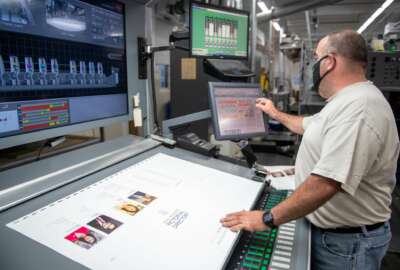Hubbard Radio Washington DC, LLC. All rights reserved. This website is not intended for users located within the European Economic Area.
What GPO has in common with Vera Bradley, Briggs and Stratton
Forbes Magazine's list of the 500 best mid-sized employers in the United States included a couple of federal agencies, among them the Government Publishing Offi...
Best listening experience is on Chrome, Firefox or Safari. Subscribe to Federal Drive’s daily audio interviews on Apple Podcasts or PodcastOne.
A recent list in Forbes magazine of 500 of the best mid-sized employers in the United States included a couple of federal agencies, among them the Government Publishing Office. For an update on what this congressional agency has been up to, the Federal Drive with Tom Temin turned to Director Hugh Halpern.
Interview transcript:
Tom Temin: Mr. Halpern, good to have you back.
Hugh Halpern: It’s always great to be back. Thanks for having me, Tom.
Tom Temin: So GPO made the list. You weren’t near the top of the list but you were on the list of 500. I should point out another congressional agency, [the Government Accountability Office] was a little bit higher. But we’re talking to you today.
Hugh Halpern: We’re just happy to be on the list. It’s our first time on the Forbes list. And we are really honored to be there. And it’s a real credit to our team here at GPO and the way we’ve been able to work through the pandemic and the culture we’ve been able to craft here at the agency.
Tom Temin: And talk about how you are situated at this point, in the waning days of the pandemic? I was there early on, and the place was mostly empty, and we went through masks, seeing some of the facilities, but who’s there, who’s not there, what’s the status now?
Hugh Halpern: So we are really at full production at the moment, we’ve got about 1000 people who come to work. That’s about two thirds of our workforce. The other third, the vast majority of them are full-time telework, or some sort of hybrid telework or remote work. And for us, it’s not too terribly different than I think it will be a couple of weeks from now, a month from now, a year from now, I think you’re gonna see a situation where the folks who need to come in because they’re production employees, they work with the machines that produce the Congressional Record, the Federal Register, U.S. passports and all of the other products that we produce. They have to be on site, and they’ve been on site throughout the pandemic. Now, the Congressional Record, we still had to publish that even at the height of the pandemic, same with the Federal Register. And while we took a little bit of time to make sure we could do passports safely, we’ve been producing them at pretty much full tilt since last summer. So they’ve all been coming to work, and our folks who are teleworking, our teammates, they’ve been doing a fantastic job, we have seen big productivity increases. And I think folks are happier in this kind of new environment. And we’ve actually been able to start experimenting with some things, we did not renew the lease on our Chicago office space, because most of our teammates in Chicago are full-time teleworking. And instead, what we did was we contracted with co-working space so that we could try that as a format. And we’re very interested to see the results because we think our teammates are gonna have access to more and frankly, higher quality office space than we could provide with nicer amenities. And hopefully, that’ll also help their productivity. So we’re really interested in seeing this through and the potential for really changing the way that we’ve worked as an agency in the future.
Tom Temin: And the people that are mostly or full-time teleworking, now in Chicago, or wherever could be the D.C. area, those are mainly people in policy, procurement, that kind of thing?
Hugh Halpern: Right. So the neat thing about GPO is we’ve got folks from sort of all ends of the spectrum. So on the one hand, I’ve got artisanal bookbinders, who work in the methods that were developed thousands of years ago. On the other hand, I’ve got software developers and policy folks and librarians and all sorts of folks who don’t physically need to be in the building. So the vast majority of our telework folks are finance folks. They’re human resources folks, they are engineers, they’re software developers, and designers and everything in between.
Tom Temin: We’re speaking with Hugh Halpern, he is the director of the Government Publishing Office. And what would you say makes other people say that work there, that it’s a good place to work enough to make a list of 500 out of tens of thousands of possibilities?
Hugh Halpern: Well, Tom, I think we’re known for our culture. And one of the things that when I came to the agency a little over two years ago, everybody talked about the GPO family. And frankly, I was a little worried when we went into the pandemic, are we going to lose a little bit of that close kind of camaraderie. And the fact of the matter is I think it has evolved. And it is definitely different than it was when I first got here. But we’ve still got that same kind of close knit situation where everybody relies on everybody else. And whether you’re working in production, whether you’re on the line producing passports or printing the Federal Register, or you’re working with a team trying to build out gov info, which is our trusted digital repository, where folks can go online to get free government information. I think everybody knows that they rely on everybody else, and it’s that kind of close nit camaraderie that I think really contributes to the kind of culture where people want to work. And we’re hoping to attract folks to GPO, we’ve got a number of open positions that we’re trying to hire for. And we’ve been able to attract the kinds of folks that we think are going to make GPO a great place going into the future.
Tom Temin: Couple of detailed questions: You mentioned, the passport production and State Department had problems during the pandemic, and now a backlog had developed. Are you able to ramp up to get that backlog of production done OK, because I’m wondering about the supply chain of chips, say, that are in the passports. How’s that all going?
Hugh Halpern: So we work very, very closely, both with our State Department customer, and with our other supply chain partners, some of whom are feds and a lot of folks are in the private sector. And I’m not gonna say it wasn’t challenging. But we’ve got a really, really good team involved in the design and production of the U.S. passport. And we were fairly creative in developing that product and making sure that we could meet the State Department’s needs there. And there were a number of things going on all at once. Part of it was the State Department’s ability to work through the backlog and personalized passports. But there’s also a change of product going on there. So the E passport, the electronic passport that most people have at this point that was getting phased out, we were bringing on board the next generation passport product that we’ve designed with the Department of State. And as those two products, one was ramping down and the other was ramping up, there were always issues of trying to balance the quantities. And we were able to meet State Department’s needs there. But we’re really happy that we’re mostly transitioned over to the next generation passport, which is, frankly, the most advanced identity document that you’re going to find anywhere in the world.
Tom Temin: But it still has a physical manifestation you can hold and put in your breast pocket.
Hugh Halpern: Absolutely, absolutely. And I know I’ve talked to friends who have recently gotten passports, and they’ve gotten the next generation passport, and you can tell the difference. But the Identity page is a little bit different than what you might have seen in the past. But it’s a great product. And we’re really pleased that we can work with State Department to produce that for Americans.
Tom Temin: And how has the supply chain been for the paper, the inks and the various specialized products that GPO uses in production of books and things like the Federal Register and the Congressional Record?
Hugh Halpern: Paper is in very short supply, and it is a constant challenge. But we have both great teams here in our production departments. And frankly, our acquisition team is very, very good at, combing the nation to find what we need. But I’d be kidding you if I didn’t say it was hard sometimes to make sure that we’ve got everything that we need. But there’s one case where one of our GPO teammates realized that we had very wide rolls of paper down in our warehouse, and that if we were able to cut that paper in half, we would actually extend the supply of paper we would need for some of the products we printed. So we’ve got a whole bunch of talent here at GPO. And that’s just one example of the kinds of creative problem solving that they can come up with that really let us come up with some creative solutions to meet our customers’ needs.
Tom Temin: So in that case, you run the roll through a press with no plates and just operate the splitter?
Hugh Halpern: Well we actually sent that out to another company that would split the roll for us, but it was actually a huge find. And it actually extended our paper supply by a number of weeks. So it was just a good example of the kind of ingenuity that our team is able to come up with day after day.
Tom Temin: Hugh Halpern is director of the [Government] Publishing Office. Thanks so much for joining me.
Hugh Halpern: Hey, thanks for having me, Tom. It is always great to talk to you.
Copyright © 2024 Federal News Network. All rights reserved. This website is not intended for users located within the European Economic Area.
Tom Temin
Tom Temin is host of the Federal Drive and has been providing insight on federal technology and management issues for more than 30 years.
Follow @tteminWFED
Related Stories
Related Topics





